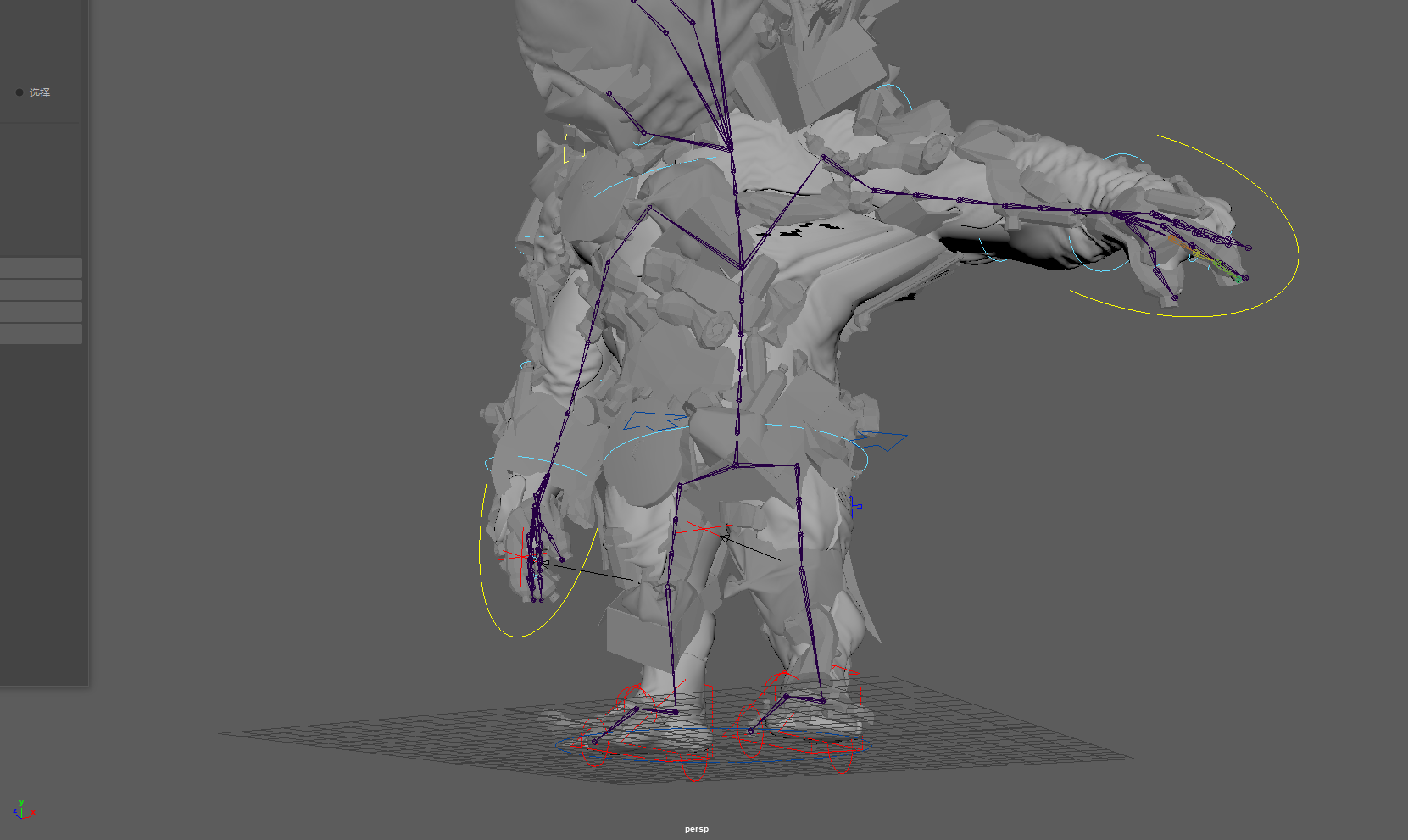
Start by adding an overall character skeleton to the Human IK panel, then constantly adjust and add joints and positions that fit the monster based on its shape. Also, when creating a hand skeleton, consider whether the hand skeleton is divided into four fingers, and the space between the fingers determines the Angle at which the skeleton needs to rotate. Thus, you can create and bind bones without modifying their rotation, but you can accept position information. In the process of creating fingers, there is always a certain curvature in the joints of the monster’s bones, and you should try to avoid breaking the first rule when adjusting him. When crafting skins, automatic brushing of skin details is often poor and requires additional adjustment of monster weights.
While learning how to control monster bones, I also learned reverse dynamics and forward dynamics in 3D animation. Forward dynamics is necessary to create detailed circular motion, as it requires directly setting the rotation of each joint of the garbage monster. Reverse dynamics is necessary to create direct target motion because it only requires setting the position and direction of motion of the end joint in the joint chain. To position the joint chain, rotate each joint one by one. For example, in order for a joint chain to reach a specific location in space, each joint in a keychain must be rotated one by one. To do this, you will first rotate the parent joint of the joint chain, then rotate the next joint, and proceed along the chain in turn. In this case, I often make mistakes in the parent-child joint, but this can be tested repeatedly to know whether the joint position is in the parent-child position or the parent-child position, so the statement in this part may not be very clear. When using forward dynamic animation of bones, Maya adds joint rotation starting at the root joint, followed by subjoints of the root joint, following the skeleton hierarchy.
Due to the complexity of the monster model, multiple joints need to be created close to each other (using short bones) to ensure smooth movement of the joints when animating curves. Especially when it comes to creating monster foot bones, it’s a very complicated system for me. You need to look at the position of the human foothold and then control the foot. For example, when walking forward or backward with the bone of the foot raised, move the feet back and forth alternately, with the pelvis always centered on the foot in the forward and backward direction. This is often prone to control errors. When creating the control joint for my left foot, I first selected the RightFoot joint for ease of use and then hid it by pressing Ctrl+h on my keyboard. Go to the side view and select Animation> from the main menu
When the controller is able to control the movement of the skeleton, the skeleton needs to be bound to the monster model. I’ve been trying this part for almost two nights. Since the monster models were made up of a lot of junk and were not created with the need for subsequent animation in mind, the models were not as standardized as in the video teaching. So, the whole night, 2 repeated mistakes, very painful, let me almost want to give up, animation always has bones, the controller can control the bones, but the monster’s body does not move. At first, I thought it was a problem with the controller Settings, but in fact, the model is difficult to attach skin, and the model often has stretching problems.
Learning reference:
Lee, H.J. and Chen, Z., 1985. Determination of 3D human body postures from a single view. Computer Vision, Graphics, and Image Processing, 30(2), pp.148-168. Available at: https://www.sciencedirect.com/science/article/pii/0734189X85900945 /. (Accessed:March 5, 2023)
Roberts, S. (2012). Character animation fundamentals: developing skills for 2D and 3D character animation. CRC Press. Available at: https://books.google.co.uk/books?hl=zh-CN&lr=&id=k4bOAwAAQBAJ&oi=fnd&pg=PP1&dq=3D+character+animation+maya&ots=6aXb1qNuoz&sig=zlVFzXgNJqu946S38vOXpXyeBt8#v=onepage&q=3D%20character%20animation%20maya&f=false /. (Accessed: March 5,2023)
Maraffi, C. (2003). Maya character creation: modeling and animation controls. New Riders. Available at:https://books.google.co.uk/books?hl=zh-CN&lr=&id=1GE6YbntJrQC&oi=fnd&pg=PR13&dq=3D+character+animation+maya&ots=Jd71ToLU6W&sig=l3I_9hhPlmE7K8VLRLGQsMkCfHc#v=onepage&q=3D%20character%20animation%20maya&f=false/. (Accessed: March 5,2023)

